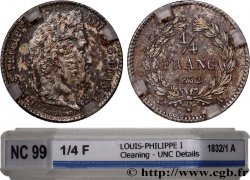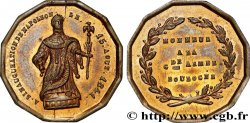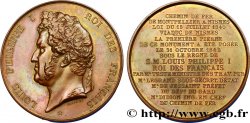fme_412283 - LOUIS-PHILIPPE I Médaille des Chemins de Fer de Montpellier à Nîmes
Not available.
Item sold on our e-shop (2024)
Price : 250.00 €
Item sold on our e-shop (2024)
Price : 250.00 €
Type : Médaille des Chemins de Fer de Montpellier à Nîmes
Date: 1842
Mint name / Town : 34 - Montpellier
Metal : bronze
Diameter : 51,5 mm
Orientation dies : 12 h.
Engraver BARRE Jean-Jacques (1793-1855)
Weight : 77 g.
Edge : lisse + proue BRONZE
Puncheon : Proue (1842 - 1845)
Coments on the condition:
Superbe médaille dans sa boite ronde en bois d’origine
Obverse
Obverse legend : LOUIS PHILIPPE I - ROI DES FRANÇAIS.
Obverse description : Tête laurée de Louis-Philippe Ier à gauche.
Reverse
Reverse description : Légende en 16 lignes.
Commentary
Médaille signée BARRE Ft. Jean-Jacques Barre (né le 3 août 1793 à Paris et mort le 10 juin 1855 à Paris) est le 17e graveur général des monnaies à la Monnaie de Paris de 1842 à 1855. Il est le dessinateur et graveur des deux premières séries de timbres-poste de France, les types Cérès et à l'effigie de Napoléon III.
L'ordre de ses prénoms varie selon les publications : Jean-Jacques Barre en numismatique et Jacques-Jean Barre en philatélie. Barre entre comme ouvrier graveur vers 1810 à la Monnaie de Paris. Après la mort en 1842 de Nicolas-Pierre Tiolier, il lui succède en tant que graveur général des monnaies. Le roi Louis-Philippe Ier lui commande en particulier de larges portraits en médaillon de plâtre des nombreux membres de la famille royale.
La Compagnie fermière du chemin de fer de Montpellier à Nîmes exploita à bail un chemin de fer entre ces deux villes.
Construit sous la Monarchie de Juillet, le chemin de fer entre Montpellier et Nîmes forme le complément du Montpellier-Sète et du chemin de fer du Gard.
Après une première tentative infructueuse, en 1838, et afin de relancer la confiance de l’initiative privée dans les chemins de fer, l’État se charge de la construction de la ligne qui s’étalera de 1840 à 1844.
À l’issue d’une adjudication, l’exploitation du chemin de fer est confiée, en 1844, à une entreprise privée en contrepartie du versement d’un loyer.
Ne pouvant faire face à ses obligations, la société d’exploitation trouve son salut dans une fusion, en 1852 sous le Second Empire, avec d'autres compagnies pour donner naissance à la Compagnie du chemin de fer de Lyon à la Méditerranée qui dessert tout le sud-est du pays à partir de Lyon..
L'ordre de ses prénoms varie selon les publications : Jean-Jacques Barre en numismatique et Jacques-Jean Barre en philatélie. Barre entre comme ouvrier graveur vers 1810 à la Monnaie de Paris. Après la mort en 1842 de Nicolas-Pierre Tiolier, il lui succède en tant que graveur général des monnaies. Le roi Louis-Philippe Ier lui commande en particulier de larges portraits en médaillon de plâtre des nombreux membres de la famille royale.
La Compagnie fermière du chemin de fer de Montpellier à Nîmes exploita à bail un chemin de fer entre ces deux villes.
Construit sous la Monarchie de Juillet, le chemin de fer entre Montpellier et Nîmes forme le complément du Montpellier-Sète et du chemin de fer du Gard.
Après une première tentative infructueuse, en 1838, et afin de relancer la confiance de l’initiative privée dans les chemins de fer, l’État se charge de la construction de la ligne qui s’étalera de 1840 à 1844.
À l’issue d’une adjudication, l’exploitation du chemin de fer est confiée, en 1844, à une entreprise privée en contrepartie du versement d’un loyer.
Ne pouvant faire face à ses obligations, la société d’exploitation trouve son salut dans une fusion, en 1852 sous le Second Empire, avec d'autres compagnies pour donner naissance à la Compagnie du chemin de fer de Lyon à la Méditerranée qui dessert tout le sud-est du pays à partir de Lyon..








 Report a mistake
Report a mistake Print the page
Print the page Share my selection
Share my selection Ask a question
Ask a question Consign / sell
Consign / sell
 Full data
Full data










